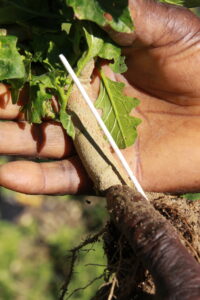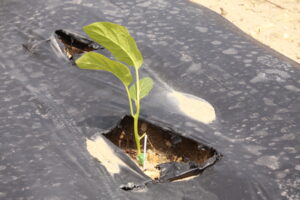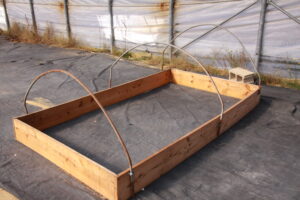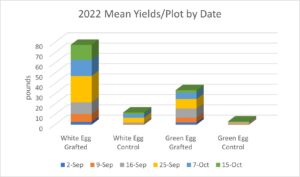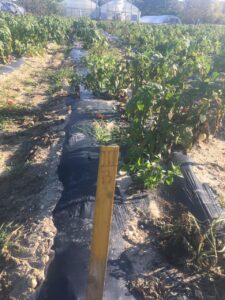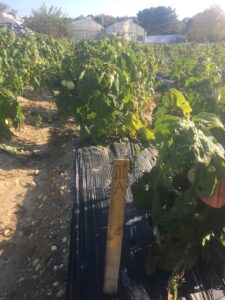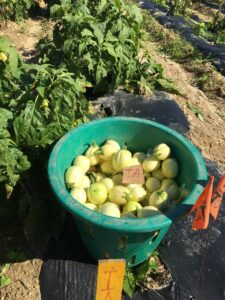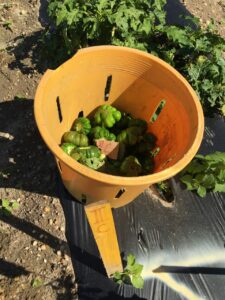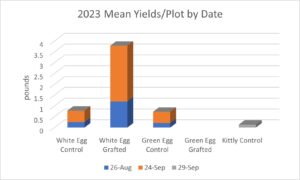Final report for FNE22-011
Project Information
This project was conducted to evaluate grafting of heritage African eggplants onto rootstocks of vigorous, disease resistant plants (tomato) to see if I could increase yields which have been in steady decline after several years of producing on the same land. I also wanted to find out if I could graft my own transplants at a lower cost than purchasing them from a commercial grafting company. Seeds of rootstock were purchased and along with my own saved African eggplant seeds, were supplied to a grafting company in North Carolina, or grown in my own greenhouse for transplant production. After slowly and meticulously cutting and joining the two plants together several hundred times, I placed them in a homemade growth chamber with a cool water mister to keep the grafted seedlings in a shaded, high humidity environment for several days to increase the healing of the graft before moving them to a greenhouse to grow out. In the first season, my system did not work well. Very few of my grafted transplants survived. After several adjustments (sealing the chamber better and filling it with a couple of inches of water to keep the humidity higher, and moving the chamber from the greenhouse into my garage to reduce overheating), I had better luck the second season and was able to produce just enough plants for the field trials. Field trials were planted using only commercially produced transplants in season 1, and only my own grafted transplants in season 2. Unfortunately, the grafting company ran into their own production issues and was not able to supply my grafted transplants the second year of the trials. In both seasons, grafted plants outperformed non-grafted plants across all varieties. In the first season, no non-grafted plants survived until flowering and hence, no harvest. In the second year, I had learned about hot-water treating of seed to reduce leaf spot diseases. I had all of my African eggplant seeds treated which helped some non-grafted transplants survive, but yields of the grafted plants were still at least 2-3 times more than the non-grafted plants. To be sure, grafting my African eggplant varieties onto resistant rootstock has potential to allow me to continue production, but producing my own grafted transplants requires more fine tuning and experience before I should rely entirely only on my own. However, relying on only one commercial grafting company to produce all of my crop plants is not without risk either. My technical advisor and I are still working on a bulletin that will illustrate the positive results and some of the challenges that grafting presents for eggplant growers.
- This project seeks to determine if grafting heritage African eggplant varieties onto resistant rootstock will reduce losses to root-born and fungal/bacterial leafspot diseases and increase yield.
- This project will compare the cost and ease of producing one's own grafted transplants with those purchased from a commercial grafting company.
- This project will evaluate performance of several heritage eggplant varieties and rootstock combinations compared to non-grafted plants of same varieties.
Since farming in New Jersey, the African eggplants I grow have been dying often at the peak of the season when my customers are coming to pick them. My county agent has identified the cause of the premature death of these plants as Verticillium/Fusarium wilt, and possibly some fungal or bacterial leafspot diseases. These diseases commonly attack host plants such as eggplants, tomatoes and peppers by clogging the roots and preventing water and nutrients from getting to the leaves which turn yellow and wilt. Chemical pesticides to mitigate these diseases have not worked well or at all.
This problem is significant because my World Crops Farm is one of the single suppliers of this ethnic produce with customers coming from well beyond New Jersey, as far away as Maryland, Virginia, Connecticut and Massachusetts, western Pennsylvania and New York. It is estimated that this fungus results in annual losses of 20,000 – 25,000 pounds of produce. Each pound lost is a dollar lost, so it results in losses of $20,000 - $25,000 to my farm, and this is my biggest income crop.
My solution is to explore and test grafting my heritage African eggplant varieties onto one or more resistant eggplant/tomato rootstock types that are claimed to enhance disease resistance, plant vigor and ultimately increase yields. Studies listed in the citations have shown that grafting increases eggplant vigor and disease resistance, which sounds very promising. Working with my technical advisor, we will obtain seeds of 1-3 resistant rootstocks, set up a grafting area in my own greenhouse, but also contract to have a backup supply of grafted seedlings produced by a commercial firm (Tri Hishtil Greenhouses, Mills River, NC).
I will need to build a small humidity chamber within my greenhouse to protect the seedlings for a few days after grafting. I will also need to purchase grafting materials and supplies (clips, cutters, sanitizer, etc). Before transplanting, my farmer neighbor Ron Ruggeri suggested some modifications that need to be made to my transplanter to prevent planting the seedlings too deep, as planting above the graft will allow the top to take root and defeat the protection from the rootstock.
When ready to plant in the field, county agent Rick VanVranken will assist me with a planting arrangement that will provide a comparison of all the different rootstock/crop plant combinations. He will also guide me in rating the disease control, and measuring yields. If allowed (because of COVID-19 restrictions), I will invite other eggplant growers to view the trial. I'll also produce a report for Mr. VanVranken to share via Extension newsletters and conferences.
Though not many growers produce the same African types of eggplant, there are many growers that have some heritage types of eggplants from around the world that do not have the resistance that American hybrids contain. Therefore, this project may have potential to provide answers if they are suffering from the same types of disease pressure. Improved production will increase net farm income, provide better quality of life for farmers, and provide more of the fresh crops many immigrant communities long for.
My World Crops Farm is 13 acres that I purchased in 2015. My farm was formally a nursery greenhouse operation, so I have a large multi-bay greenhouse, and smaller hoop houses, to grow transplants. I plant most of my crops, except greens, on plastic mulch with drip irrigation. My transplanter plants through plastic mulch but needs some modification for better depth control to prevent planting too deep. Land, equipment and my time will be devoted to this project. During the summer, the farm is open for primarily pick-your-own sales with customers coming from as far away as northern Virginia and Massachusetts to pick my unique crops. I have a few grocery store customers as well.
Cooperators
- - Technical Advisor
Research
Seeds of grafting rootstock varieties (tomato cultivar 'Estamino (F1)') were obtained from a commercial source (Johnnies Selected Seeds, ME <www.johnnyseeds.com>). Both rootstock and crop transplants were grown to the 2-3 true leaf stage, grafted together, placed in a humidity chamber to heal the graft, and then grown out to transplanting size. A small humidity chamber was built in my existing greenhouse (moved to my garage after burning up the first set of seedlings grafted in 2023).
A duplicate set of rootstock and crop seeds were supplied to a commercial grafting company to make sure I have adequate planting/trialing stock.
Before the second season, it was recommended to try a hot-water treatment of my seeds to reduce seed-born bacterial leaf diseases. I worked with Rutgers Cooperative Extension to have all of my heritage African eggplant seeds treated per instructions in their Mid-Atlantic Commercial Vegetable Production Recommendations <https://njaes.rutgers.edu/pubs/commercial-veg-rec/pest-management.pdf> (Section E - 4.3 Disease Control in Seeds, Plant Growing Mix and Plant Beds, pp 129-130).
I intended to upgrade my transplanter with new planting arms, pockets and depth wheel to be able set the grafted transplants through plastic mulch at a precise depth required to keep the graft union above the soil. Unfortunately, several setbacks in this project made that investment unobtainable. I would still like to make those upgrades in the future as it will be much more efficient for increasing the use of grafted plants on the rest of my farm.
Depending on the success of my attempts at grafting and the number of seedlings available, plots of each variety/rootstock combination were set out into randomized plots, growing on black plastic mulch with drip irrigation. Each year, the experiment was replicated 4 times. Plot plans for each season are attached and include descriptions of the variety combinations we were able to test each season.
The experiment was grown in my commercial fields along with the rest of my crops and treated with the same fertilizer, irrigation, pest control, etc. Disease development was noted through the season and yields were measured on each plot for comparison.
The experiment was conducted twice, in 2022 and repeated in 2023. However, due to poor success in my first attempt at grafting, only commercially grafted transplants were available in season 1. Issues at the commercial grafter in year 2 prevented them sending me any grafted transplants, so the trial was conducted with only my own grafted transplants.
From the outset, this project has revealed a number of unforeseen challenges for small farmers to successfully adopt grafting as a viable crop management tool. Limited availability of grafting rootstock seeds from commercial sources prevented me from being able to graft enough of my own plants for my 2022 trials. In addition, the first attempt to build a humidity chamber for healing the grafted plants was either not warm enough and/or humid enough to successfully graft the few plants I tried. Luckily, the commercial grafting firm (Tri-Hishtil, Mills River, NC <www.trihishtil.com>) that I had begun to work with was still able to supply me with grafted seedlings of two of my African eggplants that I was able to grow, though later in the season than I had hoped, along with some non-grafted control plants for a smaller trial.
Additionally, my misunderstanding of the funding process prevented me from being able to invest in the transplanter improvements that I had proposed, so I had to resort to transplanting by hand. It was good, in that respect, that the trial had to be downsized. That said, on July 15, 2022, I transplanted two types (White Garden Egg and Green Garden Egg) of commercially grafted eggplants into a blocked (by type) random planting along with non-grafted seedlings of the same varieties that I had grown to the same age. The plot was located within a block of my own eggplants and planted on black plastic mulch with drip irrigation underneath. Fertilizer and insect control were applied to the plots at the same time the rest of the crop block was treated through the season. The final plot plan is attached.
The season 1 plots were harvested six times through the season when the fruit was at a marketable stage, and total weight of fruit per plot were recorded. Disease pressure and plant survival were observed as the season progressed. Crop progress was photographed through the season. The harvest summary table shows mean yields per 15 plants per plot throughout the season totalled for each variety.
2022 Harvest Data
Heritage White African Garden Egg - non-grafted, grafted, and single harvest from 15 grafted plants.
Heritage Green African Garden Egg - single harvest from 15 grafted plants.
The season 2 plantings were planned for an earlier start (mid-May target planting date) with seeds sent to Tri-Hishtil in late February, with a target concurrent seeding date of March 5 to be able to meet the field planting date. At the end of May, Tri-Hishtil, finally responding to my multiple attempts to contact them, indicated their greenhouses had been quarantined and shut down by USDA APHIS due to an infestation of Tomato Rugous Fruit Virus. My plants were among those that USDA ordered to be destroyed. They would not be able to supply any of my grafted transplants, including those for my entire season's production plantings.
In the meantime, several attempts to graft seedlings at home provided significant learning experiences. A few early grafting attempts worked and produced usable transplants. However, as the season got progressively hotter, later plantings, despite initially looking good after grafting, burnt up due to excessive heat within the chamber. It was concluded that the bright sun in the greenhouse was overheating the black plastic covered humidity chamber. I moved the chambers to my cement block garage which corrected the overheating, but delayed grafting work. Eventually, enough grafted seedlings survived to allow planting a smaller field trial. On July 6, 2023, I transplanted one type (White Garden Egg) of my own grafted eggplants into a random planting along with non-grafted seedlings of the same variety that I had grown to the same age. The attached 2023 plot plan also shows that some non-grafted Green Garden eggplants and some grafted Kittly eggplants were included for observation and to fill out the planting. Unfortunately, the grafted Green Garden eggplants were among the first grafted plants that burnt up in the greenhouse and there wasn't time to produce replacements. The Kittly type is a very slow growing plant and was planted too late to produce harvestable fruit.
As in the previous season, the plot was located within a block of my own eggplants and planted on black plastic mulch with drip irrigation. The next setback, however, was that the mulch had been applied in early May in anticipation of the May 15 target planting date. Much of the mulch was starting to disintegrate by the time the plot was planted and a heavy weed infestation was beginning. Plots had to be hand weeded in late July in order for the crop to survive. Otherwise, fertilizer and insect control were applied to the plots at the same time the rest of the crop block was treated through the season.
The season 2 plots were harvested two times due to the late planting that delayed fruit maturity until near the end of the season. The total weight of fruit per plot was recorded, as shown in the attached harvest summary table. Disease pressure and plant survival were observed and photographed as the season progressed.
The harvest summary table shows mean yields per 6 plants per plot and showing the total of 2 harvests for the White Egg, and one later harvest of immature fruit for Kittly. The season ended earlier due to a heavy frost the first weekend of October.
I challenged myself to learn how to graft eggplant seedlings onto tomato/eggplant rootstock to increase the vigor and disease resistance of my heritage African eggplants. It has been increasingly difficult to produce the most popular crop that I grow for my customers. Despite the challenges and setbacks encountered in the implementation of this project, the outstanding performance of my heritage African eggplants grafted to hardy tomato rootstock proved very positive. At least for the White Garden Egg, they survived with no leaf spotting, yellowing or dropping, and produced outstanding yields in both seasons, from both commercially grafted and self-grafted plants. I am convinced that I need to continue learning how to graft my own, as well as find several reputable grafting companies as a backup until I am able to consistently produce my own. Since beginning this project, I have learned about others (Grafted Growers, LLC, Raleigh, NC <graftedgrowers.com> and Re-DiVined, Bainbridge, PA <redivined.weebly.com>) that may be able to help me not "put all of my egg(plant)s in one basket", though prices among the various companies vary from $1.20 to $2.00 per grafted transplant.
Education & Outreach Activities and Participation Summary
Participation Summary:
Per description of Other Educational Activities above, informal updates about this project's activities, challenges and preliminary results were shared with Rutgers Cooperative Extension faculty and staff during bi-monthly roundtable meetings of the NJAES Vegetable Working Group. This group is in charge of developing educational program sessions for the annual NJ Agriculture Convention and Trade Show (NJACTS) where a talk or session will include a presentation about this project after completion. In 2023, the leadership of the Vegetable Growers Association of NJ (VGANJ) and the NJAES Vegetable Working Group the educational programming for the NJACTS was modified and our results were too late to meet the proposal deadlines for the 2024 program. We will offer to present the results, hopefully with another season of good experiences with grafted eggplants, at the 2025 NJACTS. During that time we will also develop a summary bulletin and article about this project for a post in the Rutgers NJAES Plant & Pest Advisory newsletter that has over 750 subscribers to the vegetable crops edition that is distributed statewide, and beyond.
Learning Outcomes
Knowledge and skills gained included how to graft desirable eggplant types onto hardier rootstock plants, including things that worked well (increasing humidity with cool misters and flooding of humidity chambers) and those that didn't (locating humidity chambers in a hot greenhouse leads to temperatures high enough to kill the grafted transplants, despite being in the dark and with cooling mist). Moving the humidity chambers into a cool, dark garage helped the tender grafted plants survive.
Attitudes changed by our awareness that grafting has great potential to increase plant survival in the field, ultimately saving my production and allowing me to continue to grow specialty heritage African eggplants for my community. I am also aware that commercial grafting companies may be much more suited to producing transplants for me, but can also run into production challenges, so I cannot rely on them, or only one of them, produce all the grafted transplants I need for my farm.
Project Outcomes
Through this project, I have met a couple of other NJ farmers who have tried using grafting to improve their heritage crops for better production. They have in turn provided me with other contacts for commercial grafting companies. Likewise, my technical advisor introduced me to his counterpart in the neighboring county who assisted and taught me about hot water treating of seeds to reduce diseases. In addition, through the course of this project, we were able to find additional information resources that provided much more detailed descriptions and procedures for grafting. The most useful were the "Grafting Guide - A Pictorial Guide to the Cleft and Splice Graft Methods as Applied to Tomato and Pepper" compiled by N. R. Bumgarner and M. D. Kleinhenz, (Ohio State University Extension), the "Grafting Manual - How to Produce Grafted Vegetable Transplants" (ed. by Kubota, C., Miles, C., and Zhao, X. <www.vegetablegrafting.org/resources/grafting-manual/>), and additional resources available through the grafting information portal at www.vegetablegrafting.org.
For a variety of reasons, I was not able to invite others to either view my field plots or see our attempts to graft the transplants during the process. I hope that the photos taken of this project can be shared via a technical bulletin and/or a presentation at an Extension meeting. The best result of this project is that it taught me what I can and must do to be able to continue producing my special African eggplants that my customers love so much.
While the overall approach and the field trials in this project were sound, the challenge/failure in the methodology was that adequate preparation and understanding of the process of grafting was not fully understood before starting. The need for better environmentally controlled chambers was hampered by the misunderstanding that funding of the project would be based on reimbursement of expenses. Hence, we built what we could on a shoestring which, combined with some mistakes like locating the chambers inside a greenhouse, ultimately led to lower success in our own attempts at grafting transplants. If done over, a better environmental chamber, built in a cool building rather than a greenhouse, needs to be fully functional and ready to go before any attempts to start grafting. Despite those challenges and setbacks, the field trials did show that grafting is a useful technique for increasing survival and production of otherwise susceptible heritage crops. I do plan to continue to use grafted transplants, likely from several different grafting companies, until I have enough experience to successfully produce my own. Any growers experiencing challenges growing heritage crops should consider grafted transplants, especially in combination with hot-water treatment of the seeds. They will be pleasantly surprised at the outcome.
